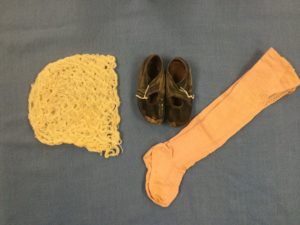Merritt Family Artifacts Return to Sheridan, by Way of Cornell University
By Virginia Becker
The Covid pandemic raised havoc among educational institutions, shutting down most to the public. With no in-person visitors to serve, many institutions devoted extra time to evaluating their collections. Sometimes duplicate examples of artifacts are discovered in an inventory, and it may be beneficial to deaccession (remove) the items from the collection. Such was the case for the Cornell Fashion and Textile Collection in Ithaca, N.Y. with eighteen pieces of children’s clothing and shoes that had been donated to Cornell several years ago by a graduate from Sheridan, N.Y.

Initially, the collection’s curators offered the items to the Chautauqua County Historical Society at the McClurg in Westfield, N.Y. As it happened, the McClurg was also conducting an inventory and found it had enough examples of this type in its textile collection. But since the items were originally worn by Sheridan residents in the early 1900s, a representative of the McClurg suggested the Sheridan Historical Society as a suitable home. In the fall of 2022, Lisa Romano, a trustee for the society, drove to Ithaca to pick up a box that included children’s booties, shoes, stockings, a bib, a bonnet, cotton dresses, and a nightgown. All of the items were part of a large collection of clothes and patterns donated to Cornell in 2009 by representatives of Rachel Merritt. They had been worn by Rachel and her brother as young children.
Rachel Alice Merritt (1904 – 1995) was the daughter of James Tooke Merritt and Luella Moon Merritt, the second of four siblings. Her mother died shortly after Rachel turned three. She and her brother, James Manley Merritt, appear to have remained with their father, while their older brother and younger sister, Nelson Herbert Merritt and Barbara Grace Merritt, went to live with their grandparents, Nelson G. and Alice T. Merritt, and Aunt Bessie Merritt. Barbara was just 4 months old at the time. Rachel subsequently had four half-siblings after her father remarried.
In addition to being a thoughtful preserver of family artifacts, Rachel was also a distinguished graduate of Cornell University, which was no small achievement for a woman of her era. A brief biography on Rachel’s Findagrave.com page states that she graduated from Cornell University in 1928 and received a master’s degree from Columbia University’s Teachers College. She taught homemaking in Alexandria Bay, N.Y. and was a home demonstration agent near Massena and for Broome and Otsego Counties. She served with the New York State Cooperative Extension Service for 32 years and was Assistant State Leader of Home Demonstration Agents when she retired in 1963.
Rachel was brought home for burial near her mother and father in the Sheridan Center Cemetery. Over one hundred years after they were worn, a portion of Rachel’s childhood clothing made it back to Sheridan as well.






